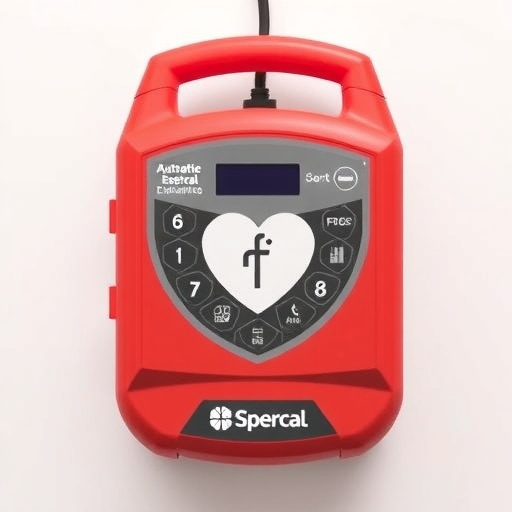Automated External Defibrillators in Private Homes: Balancing Life-Saving Potential with Cost-Effectiveness
Cardiac arrest remains one of the most critical medical emergencies worldwide, where the timely intervention with defibrillation can mean the difference between life and death. A groundbreaking study recently published in JAMA Internal Medicine sheds light on the efficacy of automated external defibrillators (AEDs) when deployed in private residential settings. This comprehensive analysis integrates clinical outcomes with economic evaluations, offering a nuanced understanding of the role home-based AEDs can play in managing cardiac arrest events characterized by shockable rhythms.
Central to this investigation is the identification of improved patient survival rates attributable to the availability and use of AEDs in private homes. The study meticulously tracked incidences of cardiac arrest where victims exhibited shockable rhythms—typically ventricular fibrillation or pulseless ventricular tachycardia—conditions highly responsive to defibrillation. By automating the process, AEDs empower laypeople to administer potentially life-saving shocks swiftly, markedly reducing the interval to first defibrillation, a critical determinant of neurological and overall survival outcomes.
However, the study also highlights a significant challenge: the relative infrequency of cardiac arrest incidents occurring within any single household. While the presence of an AED in the home setting improves individual outcomes dramatically when used appropriately, the overall cost-effectiveness of widespread individual ownership remains questionable. The economic analysis incorporated current AED pricing, maintenance costs, and the statistical probability of cardiac arrest occurrence per household, concluding that the financial burden of universal AED distribution in private residences does not align with the health benefits gained on a population scale.
This juxtaposition between life-saving potential and economic viability has significant implications for health policy and resource allocation. It suggests that while strategic placement of AEDs in public spaces and high-risk community zones remains imperative, extending this model to encompass individual homes should be approached with caution. The findings provoke a reassessment of funding priorities, encouraging investment in targeted deployment rather than blanket distribution.
Technologically, modern AEDs combine advanced biomedical engineering with user-friendly interfaces, including voice prompts, visual indicators, and wireless connectivity to emergency services. These attributes mitigate the barriers to effective use by untrained bystanders. The study’s data affirm that technological democratization of defibrillation, even in unsupervised home environments, contributes materially to increased survival chances and underscores the critical role of innovation in medical device design.
From a cardiological perspective, the efficient reversal of shockable rhythms hinges on the minimization of downtime—the period from collapse to successful defibrillation. This study elucidates how AED availability in homes truncates this interval significantly compared to scenarios reliant solely on emergency medical services arrival, which can often be delayed by logistical and geographic factors. The research amplifies the urgent need for public education in recognizing cardiac events and deploying AEDs expeditiously.
The research also delves into the socio-political dimensions of AED implementation. Policymakers face the complex task of balancing scientific evidence, cost parameters, and public health goals. The study offers a framework for considering cost-effectiveness analyses as an integral component of future resuscitation science policies, particularly in the burgeoning arena of home care and personal medical technology.
By integrating interdisciplinary perspectives—ranging from biomedical engineering and internal medicine to health economics and public policy—the study provides an exhaustive assessment of AED deployment in private homes. This holistic approach offers clarity for stakeholders across the health care continuum on optimizing cardiac arrest response ecosystems without incurring unsustainable expenditures.
The revelations from this research also encourage innovation in reducing AED costs and enhancing accessibility. The possibility remains that future technological advancements could lower manufacturing expenses, improve durability, or introduce multi-functional devices that justify individual household investment. Such progress could potentially shift the current paradigm, rendering home AED ownership more financially and medically viable.
Moreover, this study arrives at a pivotal moment where home-based health interventions are gaining momentum. With increasing emphasis on personalized medicine and decentralized care, integrating life-saving devices like AEDs into the home environment aligns with broader healthcare transformation trends. Still, the study cautions against premature widespread adoption absent robust cost-benefit validation.
The lead author, Lars W. Andersen, MD, MPH, PhD, DMSc, provides a compelling narrative emphasizing nuanced decision-making informed by rigorous data. He underscores the importance of prioritizing AED placement in locations with higher incidence rates and public accessibility while continuing research into optimizing home use scenarios.
Presented at the prestigious European Resuscitation Council Congress, this study invites dialogue among clinicians, engineers, policymakers, and the public. It reinforces the imperative of evidence-based strategies in the deployment of medical technologies that have profound implications on survival but equally complex economic footprints.
In conclusion, while automated external defibrillators demonstrably improve survival in cardiac arrest cases within private homes, the current cost barriers preclude them from being a universally cost-effective solution. This research heralds a future where targeted AED accessibility, combined with technological advancements and informed policy, could redefine life-saving cardiac arrest interventions, advancing global health outcomes in a financially sustainable manner.
Subject of Research: Automated external defibrillators (AEDs) efficacy and cost-effectiveness in private homes for cardiac arrest patients with shockable rhythms.
Article Title: (Not provided in the original content)
News Publication Date: (Not provided in the original content)
Web References: Not provided.
References: (doi:10.1001/jamainternmed.2025.6123)
Image Credits: (Not provided in the original content)
Keywords: Cardiac arrest, Shock waves, Home care, Cost effectiveness, Medical equipment, Cardiology, Internal medicine




